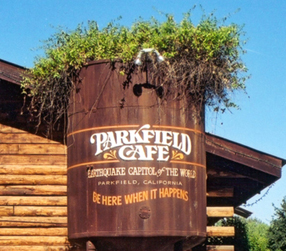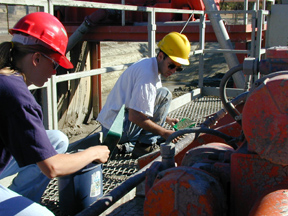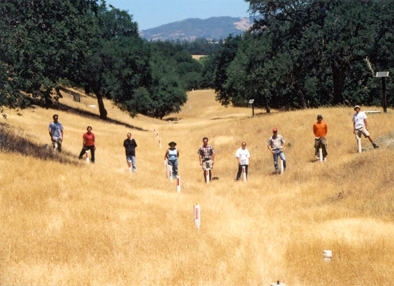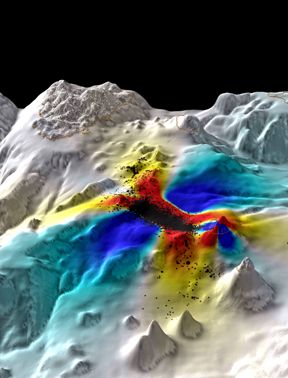Geotimes

Web
Extra
Wednesday, September 18
Parkfield's questionable stress
factor
Sidebar: Izu
Islands' stresses
Web Links
 Like a
toy on a spring wound up again and again, the Parkfield segment of the San Andreas
Fault should have snapped sometime in the late 1980s or early 1990s, according
to the time-predictable model of large earthquakes. The fault segment had failed
regularly about every 22 years until 1966, and then, nothing. That last earthquake,
at magnitude 6.0, has left geologists and residents of Parkfield, Calif., waiting
for the next one ever since.
Like a
toy on a spring wound up again and again, the Parkfield segment of the San Andreas
Fault should have snapped sometime in the late 1980s or early 1990s, according
to the time-predictable model of large earthquakes. The fault segment had failed
regularly about every 22 years until 1966, and then, nothing. That last earthquake,
at magnitude 6.0, has left geologists and residents of Parkfield, Calif., waiting
for the next one ever since.
A water tower in downtown Parkfield
claims the city as the "Earthquake Capitol of the world." Photo by
Alvin Chan.
This lack of performance, though disappointing, allowed Jessica Murray and
Paul Segall of Stanford University to begin to disprove the idea that faults
occur on a predictable cycle that depends on stress accumulation over time.
The time-predictable earthquake model was first quantified in the literature
in 1980, by Shimazaki and Nakata, but the idea goes back to H.F. Reid and his
fabled analysis of San Francisco's 1906 earthquake, for which he postulated
on elastic rebound recovery.
Presumably, the amount of stress accumulated over time along the same stretch
of a fault should be the same to set off a major earthquake each time. Using
several methods and two different data sets of strain accumulation, Murray and
Segall report in this week's Nature that the Parkfield segment reached
that recovery point threshold sometime between 1973 and 1987 - and then exceeded
it, and Parkfield still did not fail.
Some of the possible explanations for the failed predictability of this formerly
clockwork-like fault are fault interactions nearby. The Coalinga earthquake
in 1983, for example, may have changed the stress regime in the region and delayed
the occurrence of an earthquake on the nearby Parkfield segment. Nevertheless,
Murray and Segall have shown that the stress and strain accumulations at Parkfield
are probably far beyond what triggered earthquakes there in the past.
 Parkfield
is now the most instrumented fault in the world, and a particularly apt place
to study fault failure. If it ruptures again, the data will be a goldmine. But
it will only be a log of one event, and that is not enough for scientific rigor.
The same argument goes for Murray and Segall's first run at disproving the time-predictable
model of earthquakes.
Parkfield
is now the most instrumented fault in the world, and a particularly apt place
to study fault failure. If it ruptures again, the data will be a goldmine. But
it will only be a log of one event, and that is not enough for scientific rigor.
The same argument goes for Murray and Segall's first run at disproving the time-predictable
model of earthquakes.
Jessica Murray and Berkeley graduate
student Matt d'Alessio collect samples from the material that came up out of
the SAFOD pilot hole during drilling (Geotimes September 2002). Photo
courtesy of Murray.
"For years we have been talking about the recurrence time of Parkfield
earthquakes, but if they are really different in character, 'recurrence' may
be a misleading term," says David Jackson, a geologist at the University
of California at Los Angeles. Jackson agrees with scientists who question whether
time-predictability works as a model on the premise that the occurrence of "similar"
earthquakes on a fault is unlikely. If past earthquakes on the Parkfield segment
were different enough from each other, then magnitude and slip distribution
along a fault must be considered in models of predictability.
Ross Stein, a seismologist at the U.S. Geological Survey in Menlo Park, agrees
that Murray and Segall could go back and look at past Parkfield earthquakes
to see if their conclusions apply. "You'd want to know, do they see all
earthquakes as occurring late?" Stein says, "or some early, some late,
and that the system is not as dependable or as regular as we think."
 "This is a case where highly
competent scientists have zeroed in on a situation which should come as close
as one can get to testing a hypothesis that underlies so much of the way we
all think," Stein says. "They should now try to do this elsewhere,
and Japan probably offers the best chances for doing this."
"This is a case where highly
competent scientists have zeroed in on a situation which should come as close
as one can get to testing a hypothesis that underlies so much of the way we
all think," Stein says. "They should now try to do this elsewhere,
and Japan probably offers the best chances for doing this."
Stein says that this is the most thorough effort so far to show that time-predictability
is not quite right, as Murray and Segall have looked rigorously and methodically
at strain accumulation, not just at the magnitude of past earthquakes. If this
model proves wrong for short-term periods, the impacts on hazard assessment
remain to be seen, he says.
Researchers with Murray (third from
left) pose along a fault trace at Carr Hill, south of Parkfield on the west
side of the San Andreas Fault. Photo by Jennifer Adleman.
"In a long-term average sense, [the time-predictable model] can be a good
description," Murray says, "but when it's applied to more short term
predictions, predictions that are made on a 30-year time scale, we're showing
that it doesn't work."
Naomi Lubick
Geotimes contributing writer
| Izu
Islands' stresses
 During
the summer of 2000, more than 7,000 earthquakes rumbled beneath the Pacific
Ocean, 75 miles south of Tokyo amidst the Izu Islands. One of the most
dense networks of GPS (Global Positioning System) receivers and seismometers
in the world registered each centimeter of earth shifting and shaking. During
the summer of 2000, more than 7,000 earthquakes rumbled beneath the Pacific
Ocean, 75 miles south of Tokyo amidst the Izu Islands. One of the most
dense networks of GPS (Global Positioning System) receivers and seismometers
in the world registered each centimeter of earth shifting and shaking.
A team of geophysicists capitalized on this rich data set to test a theory
about what causes earthquakes, especially prolonged swarms associated
with volcanism. Their results help validate the seismicity-rate theory
developed by Jim Dieterich of the U.S. Geological Survey in 1994. The
theory rests on first principles and laboratory experiments but has rarely
been tested in the field.
"This is the best test of Dieterich's theory," says Chris Marone,
an expert in earthquake mechanics at Pennsylvania State University.
One of the theory's key predictions is that earthquake frequencies increase
as stress rates on the Earth crust increase. The study, published in the
September 5 issue of Nature, finds this relationship in the Izu
Islands volcanic chain.
During the summer of 2000, magma
intrusion into the Earth's crust triggered a swarm of 7,000 earthquakes
in the Izu Islands south of Tokyo. The colors indicate the changes in
stress rates caused by the intrusion (warm colors indicate increases in
stress rates, cool colors indicate decreases). Earthquakes, as marked
by the black dots, occurred much more frequently in areas with high increases
in stress rates. Image by Serkan Bozkurt, USGS.
The swarm of quakes began when a conduit linking magma at depth to Miyake
volcanic island ruptured. Magma rushed out through the rupture and into
a blade-shaped crevice in the crust. Continuing magma flow expanded the
blade like a bladder filling with water and exerted an ever-increasing
pressure on the surrounding crust.
"The blade expanded for seven weeks and constantly stressed the
crust up to 1,000 times normal. It sped up the seismic clock," says
Ross Stein, a U.S. Geological Survey geophysicist and co-author of the
study.
The team used slight deformations in the Earth's surface to infer the
geometry of the magma intrusion and how it changed stress rates within
the crust. Layering a map of the observed earthquake frequencies on top
of the calculated stress rates yields the predicted relationship between
frequencies and stressing.
However, the relationship is not perfect. Almost half of the variation
in quake frequencies cannot be explained by stress rates, suggesting the
seismicity-rate theory does not capture all the complexities of quake
mechanics in the field.
Even if incomplete, the seismicity-rate theory could improve earthquake
predictions in volcanic areas like Hawaii and the Pacific Northwest. Quickly
generating a map of stressing rates after a magma intrusion could give
people days or even weeks notice that they are living in a danger zone.
Greg Peterson
Back to top
|
Links:
Animations of magma intrusion and earthquakes in the Izu
Islands
Read September's News Note:
A new chance
for Parkfield
USGS web pages on Stress
and Strain and Parkfield
Nature 1999 debate on prediction
Back to top of story
 Like a
toy on a spring wound up again and again, the Parkfield segment of the San Andreas
Fault should have snapped sometime in the late 1980s or early 1990s, according
to the time-predictable model of large earthquakes. The fault segment had failed
regularly about every 22 years until 1966, and then, nothing. That last earthquake,
at magnitude 6.0, has left geologists and residents of Parkfield, Calif., waiting
for the next one ever since.
Like a
toy on a spring wound up again and again, the Parkfield segment of the San Andreas
Fault should have snapped sometime in the late 1980s or early 1990s, according
to the time-predictable model of large earthquakes. The fault segment had failed
regularly about every 22 years until 1966, and then, nothing. That last earthquake,
at magnitude 6.0, has left geologists and residents of Parkfield, Calif., waiting
for the next one ever since. 
 Parkfield
is now the most instrumented fault in the world, and a particularly apt place
to study fault failure. If it ruptures again, the data will be a goldmine. But
it will only be a log of one event, and that is not enough for scientific rigor.
The same argument goes for Murray and Segall's first run at disproving the time-predictable
model of earthquakes.
Parkfield
is now the most instrumented fault in the world, and a particularly apt place
to study fault failure. If it ruptures again, the data will be a goldmine. But
it will only be a log of one event, and that is not enough for scientific rigor.
The same argument goes for Murray and Segall's first run at disproving the time-predictable
model of earthquakes. "This is a case where highly
competent scientists have zeroed in on a situation which should come as close
as one can get to testing a hypothesis that underlies so much of the way we
all think," Stein says. "They should now try to do this elsewhere,
and Japan probably offers the best chances for doing this."
"This is a case where highly
competent scientists have zeroed in on a situation which should come as close
as one can get to testing a hypothesis that underlies so much of the way we
all think," Stein says. "They should now try to do this elsewhere,
and Japan probably offers the best chances for doing this."  During
the summer of 2000, more than 7,000 earthquakes rumbled beneath the Pacific
Ocean, 75 miles south of Tokyo amidst the Izu Islands. One of the most
dense networks of GPS (Global Positioning System) receivers and seismometers
in the world registered each centimeter of earth shifting and shaking.
During
the summer of 2000, more than 7,000 earthquakes rumbled beneath the Pacific
Ocean, 75 miles south of Tokyo amidst the Izu Islands. One of the most
dense networks of GPS (Global Positioning System) receivers and seismometers
in the world registered each centimeter of earth shifting and shaking.